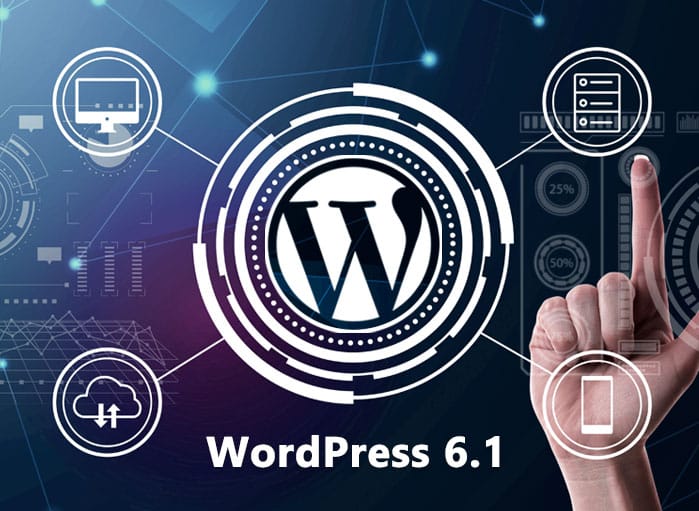
WordPress 6.1, Misha: What You Should Know
Tags: Updates,WordPress
eWay Corp November 7, 2022 7 MIN READ

WordPress 6.1, also known as ‘Misha,’ has officially been released. It’s the third and final major WordPress update of the year. This update closely follows WordPress 6.0, Arturo, and WordPress 5.9, Josephine.
WordPress 6.0 and WordPress 5.9 were released on May 24 and January 25, 2022, respectively.
The Namesake
Like other WordPress updates, WordPress 6.1 is named after Soviet-Norwegian jazz pianist Mikhail ‘Misha’ Alperin. Alperin was known for his enchanting blend of jazz and folk music. He not only founded the Moscow Art Trio but was also an eminent founding member of the first Moldavian jazz quartet.
WordPress 6.1 Makes an Entry
WordPress 6.1 rolled out on November 1, 2022.
Fans of the WordPress community always wait for any major release with bated breath. WordPress 6.1, or Misha, was not an exception.
But this time, not only the WordPress developers, but even the website owners waited for this update eagerly.
The reason for such eagerness is simple. The different release candidate phases (Release Candidate 1, 2, and 3) offered a prelude to the significant improvements that would be made to the CMS’ user experience, efficiency, and stability.
Plus, this update promised to bring to the table more enhancements and some long-demanded features, such as improved WordPress performance scores. Right from the start of this year until September 2022, the performance of WordPress has been stable.
It went up by a few percentage points during the spring, but during the summer, it witnessed a slight drop. By the end of September, the performance score was only 3 percentage points higher than the score it had at the start of the year.
Comparatively, other platforms had a better score due to their performance improvements. For instance, Wix was up by 13 points, Squarespace was up by 7 points, Duda was up by 8 points, Joomla was up by 7 points, and so on.
So, the WordPress community was hoping for some performance improvements after the update. As promised, WordPress 6.1 came with some major improvements.
WordPress 6.1: A Short Sneak-Peek
Let’s take a quick sneak-peek into what WordPress 6.1 has in store for the developers and site owners.
We know that every new WordPress release comes with newly added features, significant improvements, and bug fixes. This was also true for WordPress 6.1.
For instance, the new release comes with a new default WordPress theme 223. Similarly, 11 versions of the Gutenberg plugin have been integrated into its core. Also, a caching feature has been added to the WP_Query database. Plus, it looks forward to fixing the functionality issues before heading to Phase 3 of the Gutenberg roadmap.
As per the official statement from WordPress, the main area of work on WordPress 6.1 is to address some key issues of 6.0 Arturo and 5.8 Josephine. For instance, ‘Misha’ aims to fine-tune the site-building experiences. This means site creation is going to become a more intuitive one for developers.
The Five Key Development Areas
The Misha release promises to give more power to the site owners. After all, the WordPress 6.1 roadmap hinted toward five key development areas. Keep reading to know more about these areas. They are:
1. Block Editor Improvement
This is a boon for content creators. Most content creators spend their time on WordPress, either to create a recent blog post or a website page. For content creation, the WordPress Block Editor is needed.
As discussed above, with each WP release, tons of improvements are made to the editor. With WordPress 6.1, massive changes were made to the Gutenberg release, a code name for the block editor.
The prime focus was to bring about some uniformity to the design tools for different core blocks.
Some noticeable changes to the block editor are:
1.1. Improved Border Option
With WordPress 6.1, users will now be able to add borders to more blocks. Plus, users will be able to adjust the top, bottom, right, and left borders individually. Basically, Gutenberg 13.8 is offering support for a wide variety of border controls for Image Block. The ability to add borders with customized color selection will enable the creation of more riveting layouts and patterns for WordPress.
1.2. Improvement to Comments Block
Also, the new features that Gutenberg 13.1 has to offer to WordPress 6.1 aren’t limited to updating the Columns block. But to make use of the advanced editing feature while dealing with the Comments Title block. In fact, WP even fixed the bugs present in the Comments block styles and corrected messaging of the Gutenberg 13.2.
1.3. More Blocks to Get Dimensions
WordPress 6.1 will offer more dimensions for blocks, such as Paragraphs, List Columns, Tables, and so on. Thus, users will be able to set margins and padding for more blocks and hold better control over the layout and the design. In fact, the List Block always proved to be useful for organizing the content, either in a bullet list or numbered manner. With Gutenberg 14.0, it’s now quite easy to sort out the list items by making use of the inner blocks.
1.4. Featured Image in Cover Block
Users often get confused between featured image and Cover block. However, with Gutenberg 13.5 release, it’s now easy to add the featured image. Once added it would appear in the Cover block. In fact, WordPress 6.1 will allow users to pick and set the featured image directly. Thus, they can take full advantage of the content element.
1.5. Changes to Block Behavior Category
With WordPress 6.1, users will get to see a major change in the Categories block’s behavior. Rather than hiding them by default, users will be able to display them on the page. Previously, site owners had to use short codes in order to enable this functionality.
2. Template Editor
The template editor offers the users the ability to browse, visualize, and even edit the site structure, even if the user doesn’t have enough knowledge of the underlying code.
The main reason to bring such changes is to offer clarity between the global elements and styles. Once such clarity is brought, uniformity between the template editor and the post editor user experience would be maintained.
3. Building with Patterns
The aim of the WordPress 6.1 update is to make block patterns a supreme role in the template and page creation process for everyday users.
In simple terms, the team was keen to unlock the full potential of the block patterns highlighted in the “Building with Patterns.” This will allow the patterns to be easily tailored for custom post types and block types.
4. Global Style
As per the WP core development team’s development roadmap, significant changes to the global styles would be made. This includes updating the style engine, user experience, style variations panel, typography customization, web font, main interface, cross-block elements, per-block styles and supports, and more.
5. Themes and Wider Options
The development team rightly wanted to deal with the issues regarding the ability to adapt certain features, such as template parts on the existing legacy themes.
Also, it’s interesting to see whether WordPress 6.1 will provide full access to theme.Json editing. Similarly, users will learn how to make the best use of the new templates and styles.
The core team that worked on this WordPress update release hoped that the release would allow users to easily manage the web fonts, expand the blocks toolset, and implement responsive typography in order to improve reliability, consistency, and user satisfaction.
Now, it’s time to check what Misha has to offer to the developers and the site owners.
WordPress 6.1: What is New About It?
This update is the result of the WordPress core development team’s arduous work over many months.
It has undergone a couple of improvements, such as cache improvements, post-type improvements, multisite improvements, media handling improvements, and more.
In simple terms, WordPress 6.1 is not only going to offer major performance enhancements but also accessibility and development enhancements.
1. Performance Improvements
Different optimizations are grouped into 19 components of WordPress. Hence, some of the notable improvements that we will get to see are very few queries on REST API calls, new Site Health Checks, and more.
2. New Blocks
The Table of Contents block is going to be a completely new thing for WordPress 6.1. Content creators will now be able to add a Table of Contents to their posts. Hence, there won’t be any need to rely on third-party solutions.
3. Accessibility Improvements
WordPress 6.1 brings about several accessibility improvements to the WordPress admin dashboard, registration form, login, and even to the Site Editor.
4. Enhanced Developments
In WordPress 6.1, one will get to see a few new functions and hooks that simplify the data access process. Also, it will bring improvements to the development process.
5. Axial Spacing
Gutenberg 13.4 features the new axial spacing in the dimensional panel of the Gallery block. Users will be able to mention the distinctive horizontal and verticals gaps that need to be maintained for the images within the Gallery block while creating the image galleries.
6. Improvements to Existing Blocks
WordPress 6.1 is going to support different improvements to Comments, Cover, Columns, Categories, Galleries, Quote, List, Image, and Navigation Blocks.
7. No More JPEG to WebP Conversion
Although plans for having automatic JPEG to WebP image conversion were on the table, they were discarded. This was mainly because the users reported increased resource use on image upload.
8. New Default Block Theme in WordPress 6.1
Twenty Twenty-Three is going to be the new default block theme for WordPress 6.1. It comes with 10 style variations and new custom templates.
9. Improved Navigation Block
With the latest WordPress update, one will get to see an improved navigation block. This will allow users to create and select a menu from the block settings. Also, users can use the design tools for the submenus and style them in a unique way.
10. Design Tools for Post Navigation Links
In WordPress 6.1, users won’t need to tweak the CSS manually. Rather, Gutenberg 13.5 allows site owners to use themes with support for the appearance tools. With the tool setting property, the color and font family for Post Navigation can be completely customized.
11. New Templates for Improved Creator Experience
With new templates becoming easily accessible, site builders and developers get more control over site creation. With this new release, developers will find the custom template for posts and pages within the Site Editor.
In other words, site users will be able to create and edit template parts, such as headers and footers amazingly fast. All they need to do is to use the new tool ‘Search and Replace’ to switch the existing template with their desired one.
If a user launches the Site Editor while keeping the TT3 theme activated, 11 templates and 4 template parts will be displayed. Apart from the default ones, the flowing templates can be seen. They are:
- Blank
- 404
- Blog (Alternative)
- With Featured Image
- With Cover Block
Thus, whenever a user plans to create a new web page, they will get a list of amazing template patterns. This feature was not present in WordPress 6.0. In fact, the improved pattern feature is not only limited to templates. Rather, it extends to all post types. However, to enable this feature, users will need to add core or post content within the pattern block types and check the pertinent post types.
12. Streamlined Style in WordPress 6.1
Now, all CSS rules for padding, margin, colors, typography, and borders within the style engines are under one roof. This cuts down the time spent on layout-specific jobs and thereby creates semantic class names.
These are some of the improvements that are present within the WordPress core and for the Gutenberg editor.
Gutenberg Features are Now a Part of Classic Themes
Efforts have been made to make some features of Gutenberg more accessible in Classic themes format. This would simplify the transition to block themes.
In the event, you are using Classic Theme, but want others to modify the templates using the Block Editor, then you are lucky. To support the template parts, themes can be customized. For adding support to template parts, three steps should be carried out.
Firstly, it’s important to add the functions.php code to the file.
Secondly, a folder named Parts should be created within the theme. Within the folder, blank files, such as footer.html must be placed to add a footer pattern. Then the pattern can be easily edited from the block editor.
Thirdly, users will need to mention where they want the template part to appear on the front end. It can be added to the top-level templates, like single.php or index.php, etc. by using the help of the block_template_part() function while referring to the part name.
WordPress 6.1: Major Improvements to Block Editor
It’s worth looking into the improvements done to the block editor.
Some major additions that have been brought to the Block Editor in WordPress 6.1 are discussed in this post. Read on to know how the features can improve Gutenberg editor’s functionality for the site owners.
1. WordPress 6.1 Comes with Content Locking Experience
The content-only editing feature is a new thing for WordPress 6.1. It’s applicable for blocks, templates, and patterns. Content-locked blocks will come with block alignment and resizing. At the same time, the duotone filters would be disabled.
Content-only locking is a new type of locking for the Gutenberg editor. When content-only is enabled, site owners will be able to change the content present within the pattern or the block. The chosen block will act as a single unit while its hierarchy will remain fully hidden. This won’t allow the users to change the text and the media URL.
The block types without any content would remain completely hidden from the List View. The sidebar would only show the list of content blocks that a user will be able to modify.
2. Fluid Typography in WordPress 6.1
Developers will be able to define the optimal text size for each screen. Thus, users will be able to read and access the content in a better way. The user experience will become more responsive for the user irrespective of the device they’re using.
In other words, with fluid typography, the content becomes even more readable and aesthetically pleasing for the end-users. Similarly, developers can mention the ideal text size that deems fit for various devices, instead of having a one-size-fit concept for all devices.
3. Padding and Margin Visualization
Gutenberg 13.2 has implemented padding and merging visualization support. This will allow seeing the difference between one of the two options in a clear manner while editing a content block. The difference comes in the manner of a blue box, even though it fades out quickly.
4. Placeholder Improvements
Another noticeable improvement brought to Gutenberg 13.2 are the placeholders. From now onwards, many blocks, such as the Post Content, Comments, and Post Excerpt will display some realistic placeholders. This will offer an improved understanding of how the website will look with the content on it.
5. Time to Read Feature
Gutenberg 14.1, comes with a new feature. It’s the Time to Read feature. So, in WordPress 6.1, after accessing the information panel, one will get to see the ‘Time to Read’ thing. Basically, it will offer the users an estimated time to read the entire document.
Full-Site Editing Improvements That are Worth Noticing in WordPress 6.1
Since the release of Gutenberg, WP has been on the path to offering improved Full Site Editing (FSE) functionality.
As already discussed, WordPress 6.1 has undergone several improvements, including full-site editing improvements. This will allow WordPress site owners to have better editing experience.
So, let’s take a quick sneak peek at the FSE functionality that WordPress 6.1 is going to offer.
1. Block-Based Theme for Full-Site Editing
The block theme offers templates consisting of several blocks. This means, apart from the post content blocks, the block editor is useful to customize different areas of the WP site, such as the sidebars, headers, and footers.
2. Default Block Themes
As mentioned earlier, WordPress 6.1 comes with the default theme Twenty Twenty-Three (TT3). This block theme will come with FSE capability. Users will be able to use the various styles within the Site Editor. However, the theme focuses on the latest design tool releases.
But to see these variations, users will need to install TT3 first. Then, they will need to go to Appearance and select Editor. Next, they will need to select Styles and again Browse Styles.
However, one thing that needs to be kept in mind is that the native FSE capability of WordPress might not be so advanced.
Other Improvements Made to WordPress 6.1
Some other significant improvements brought to WordPress 6.1 are:
- The performance of a site can be improved with the help of custom taxonomies, such as tags and categories.
- One significant WordPress update or improvement is the ability to add a starter pattern modal to any kind of post type. For instance, on creating a new web page, one will get to see suggested patterns for the post and not create a new one.
- WordPress 6.1 now offers better media handling. It’s a performance boost on how images can be put back to prevent them from slowing down the webpage retrieval and display process. This boosts the site’s performance.
- One gets to see two new site health checks in WordPress 6.1. This might not be related to performance improvement, but publishers can identify whether they will be able to enhance the performance of the site by using Persistent Object Cache or Full-Page Cache.
- As a part of the WordPress update, one will get to create richer lists and quotes with inner blocks. The List and Quote blocks now allow supporting the inner blocks. This offers more flexibility and richer compositions, such as adding headings within the Quote blocks.
- The Query Block variations will support the custom queries for some enhanced variations and for some hierarchical post types with filtering options.
- By default, the site tagline is going to be empty for new sites. However, it is easy to modify in the General Settings.
- Due to the WordPress update, it is easy to control the filters within the Styles sidebar. Thus, allows controlling the settings for all four levels, such as core, user, theme, and block.
Backup and Update Your Site to WordPress 6.1
WordPress 6.1 is now available for download. WordPress site owners can easily update their websites. But before updating their site, they should run a full backup of their website. Only after that should they install WordPress Misha.
Backup is necessary in case anything goes wrong after the WordPress core update. This way, the developers and site owners can revert the changes and restore the site’s functionality.
Upgrading to WordPress 6.1
Do you have any plans to upgrade your site to 6.1?
Yes! You don’t need to worry at all. You can easily do it from the admin dashboard of WordPress. If you are facing any hurdles while upgrading to WordPress 6.1, we have got you covered. Just call the professionals of eWay Corp, and we will help you to sail through the upgradation process.
Final Thoughts
WordPress 6.1 comes with tons of improvements that are worth taking note of. It is becoming a top choice for site owners but also for developers since it offers a host of new features. With the latest WordPress update, it is now easy to maximize the performance of a site at any point of time.



